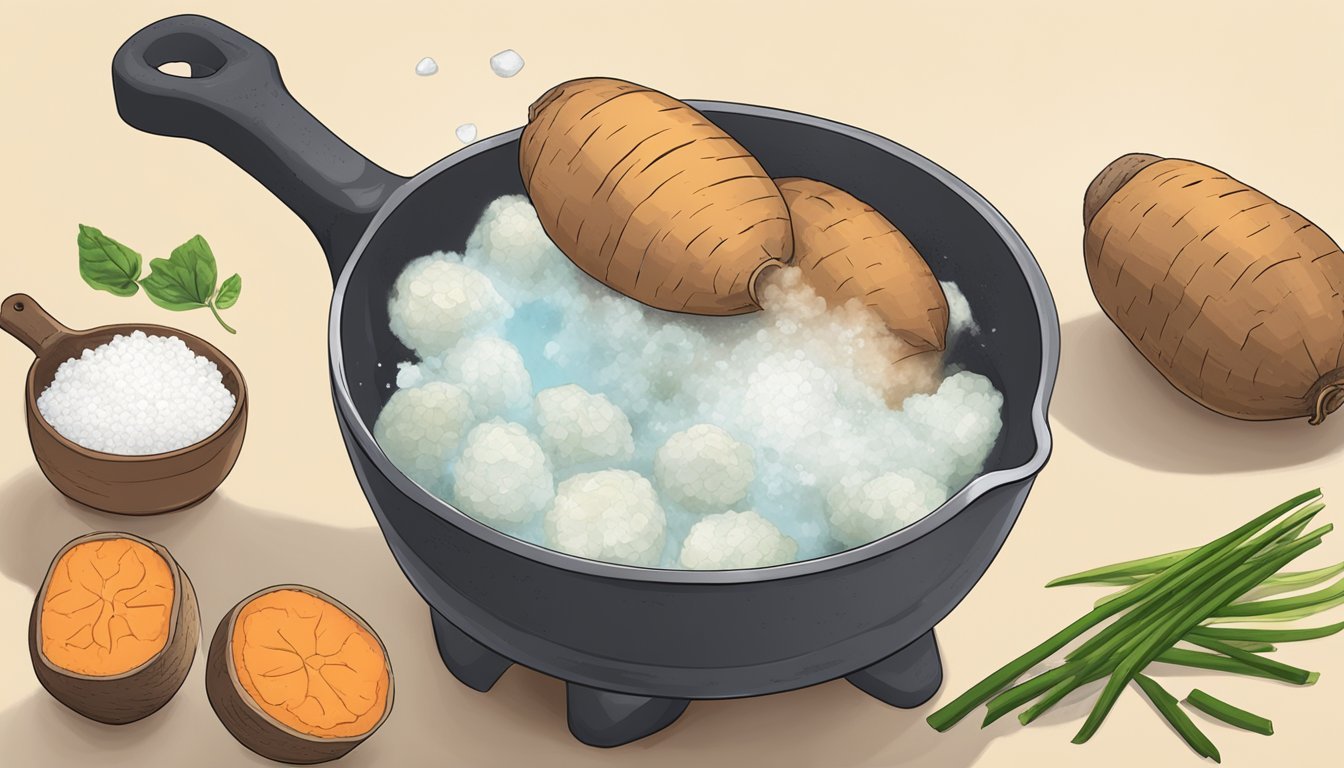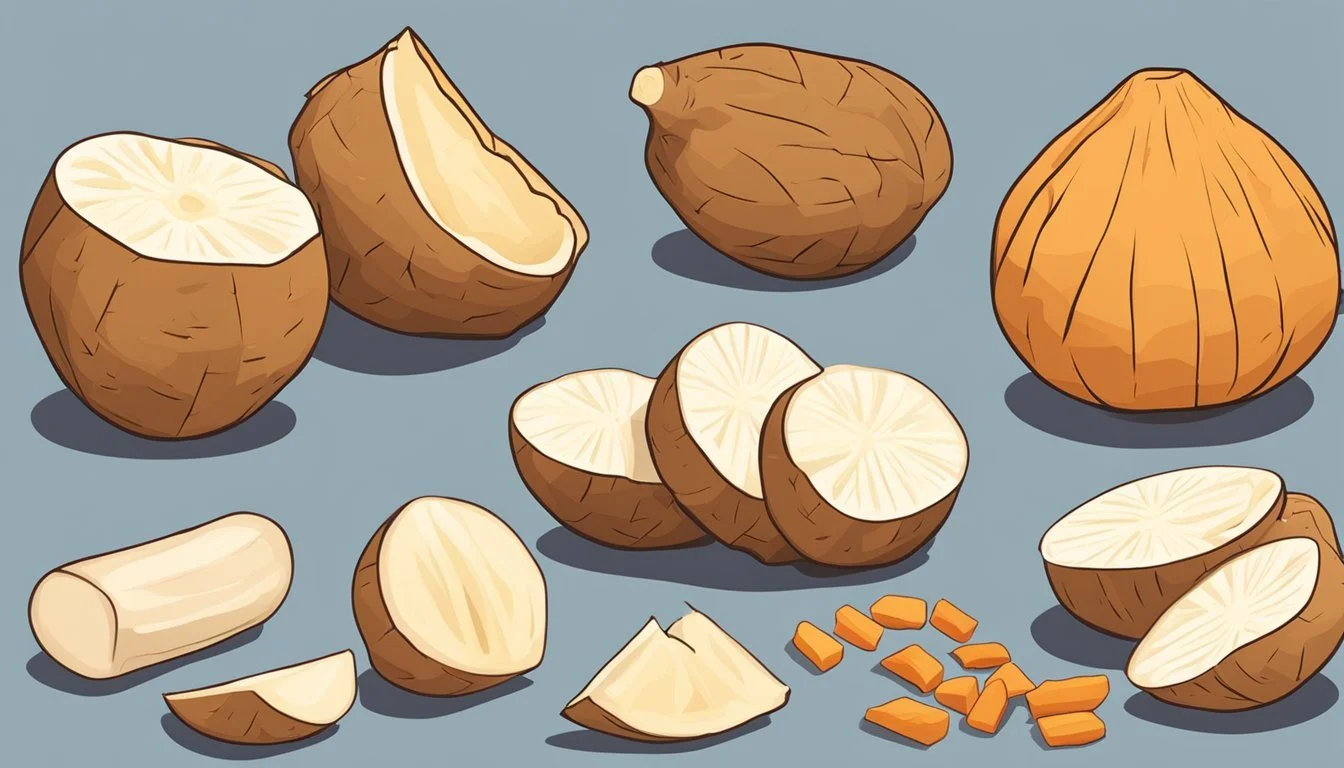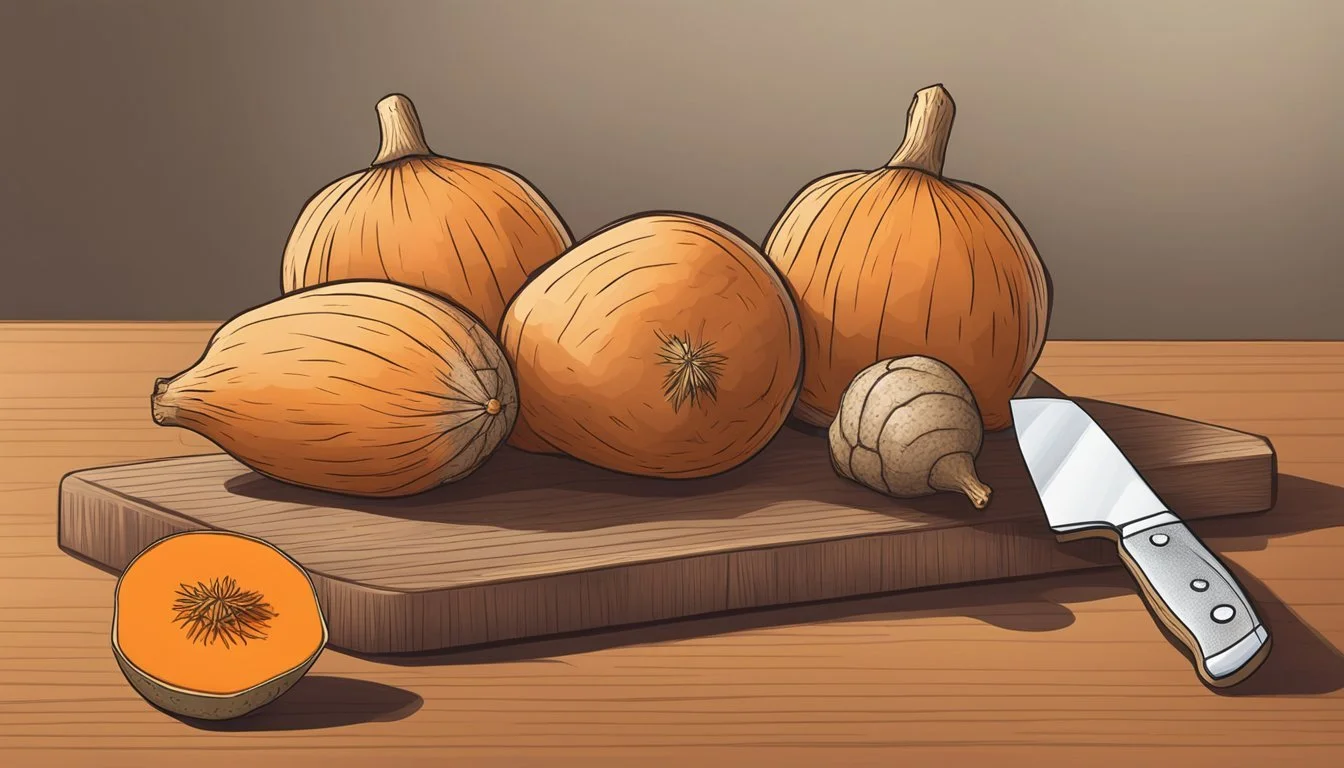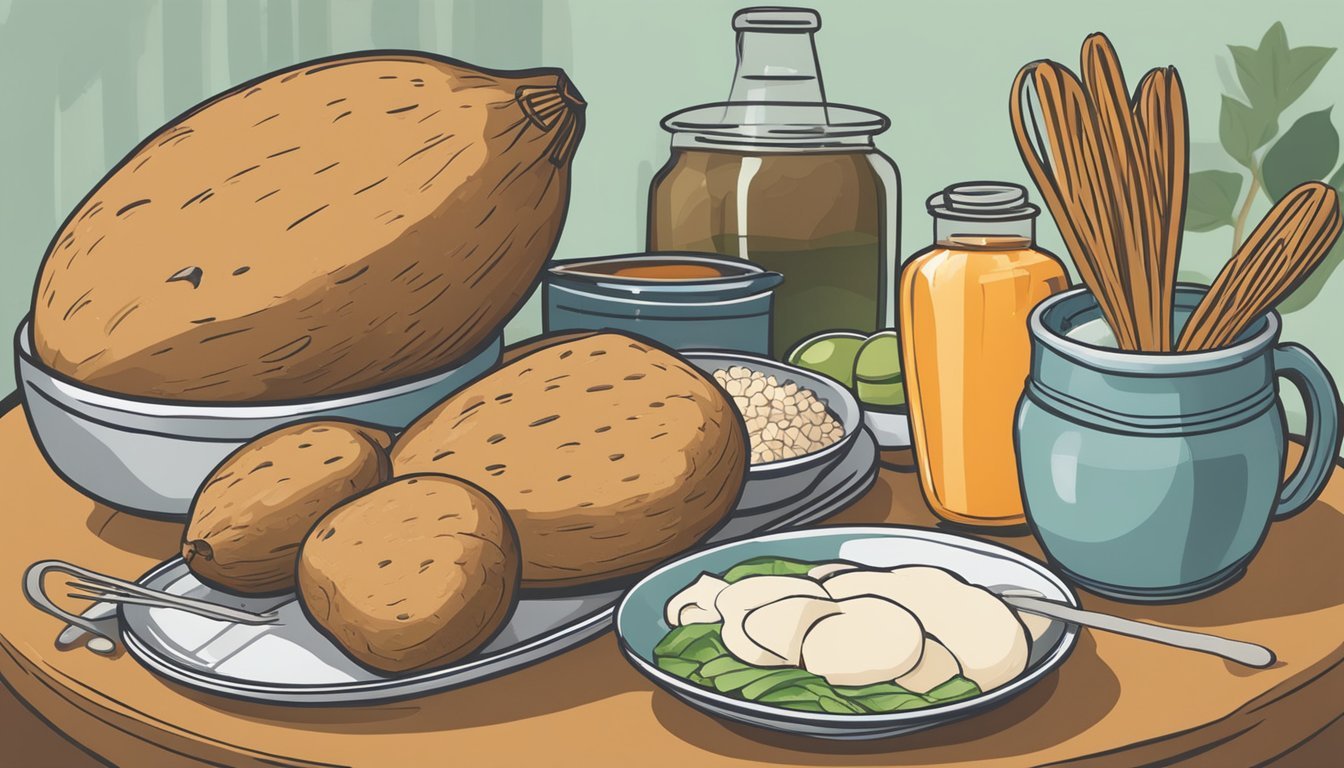How Do You Eat a Yam?
Simple Steps for Enjoying This Nutritious Root Vegetable
Yams are nutritious tuber vegetables belonging to the genus Dioscorea. They are starchy and come in various sizes and colors, ranging from white to bright orange and purple. Unlike their sweeter cousins, sweet potatoes (What wine goes well with sweet potatoes?), yams are less sugary and more earthy in flavor. Before consuming, it is essential to cook yams thoroughly, as they contain natural toxins that are neutralized during cooking. They can be prepared in a multitude of ways, including baking, boiling, and steaming, making them a versatile addition to both savory and sweet dishes.
In preparing yams, it's important to start by giving the tubers a good scrub to remove any dirt from the skin, followed by a pat dry. To enhance the texture and to ensure they cook evenly, pierce the skin of the yam a few times with a fork before cooking. When baked correctly, the inside of a yam becomes soft and tender, while the outer skin can take on a pleasantly crisp texture, creating a delightful contrast in each bite.
Yams serve as a staple food in many cultures and provide a valuable source of energy, vitamins, and minerals. They are particularly rich in vitamin C, vitamin B6, potassium, and dietary fiber. With the ability to adapt to different flavor profiles, yams are incorporated into a wide range of recipes. These tubers not only contribute to the nutritional quality of a meal but also present endless culinary opportunities for those looking to explore the breadth of starchy root vegetables.
Understanding Yams and Sweet Potatoes
Before identifying how to eat a yam, it's essential to understand the distinctions between yams and sweet potatoes and the varieties consumers encounter globally.
Definitions and Differences
A yam is a tuber from the Dioscoreaceae family. It is typically drier, starchier, and more potato-like in texture with a rough, bark-like skin. In contrast, the sweet potato is a root vegetable closely tied to the morning glory family. Sweet potatoes often have a smoother skin and can range from firm to soft, with an array of skin and flesh colors, including orange.
The confusion between the two arises particularly in the US, where the term "yam" is sometimes incorrectly used to refer to orange-fleshed sweet potatoes. True yams are prevalent in tropical regions like Africa and Asia, while in the US, what is often labeled as yams are in fact sweet potatoes.
Yams: Bark-like skin, starchy texture, used in Africa and Asia cuisines.
Sweet Potatoes: Smooth skin, sweet and soft, falsely labeled as yams in US supermarkets.
Varieties Across the World
Globally, there are many varieties of both yams and sweet potatoes. In Africa, yams are a staple food with significant cultural importance, while in parts of Asia, particularly in the Philippines and Japan, purple yams, known as ube, are popular. Sweet potatoes, on the other hand, come in two main types in the US – one with a golden skin and firm flesh and another with a softer, more orange-flesh.
Africa: Yams with off-white, purple, or red flesh.
Asia: Ube (purple yams) used in desserts and traditional dishes.
US: Orange-fleshed sweet potatoes often mislabeled as yams.
By recognizing that yams and sweet potatoes are distinct, individuals can better appreciate their unique characteristics and cultural significances.
Nutritional Profile of Yams
Yams are a nutritious staple with a rich array of vitamins, minerals, and other beneficial compounds. They are particularly noted for their high fiber and vitamin content, making them a valuable part of a balanced diet.
Vitamins and Minerals
Fiber: Yams are a good source of dietary fiber, which is essential for digestive health.
Vitamins: They provide an array of vitamins, including vitamin C, which is crucial for immune function, and vitamin A, important for vision and skin health.
Minerals: Yams are rich in minerals such as potassium, necessary for blood pressure regulation; iron, which is needed for transporting oxygen in the blood; manganese, which plays a role in bone formation and nutrient metabolism; and copper, important for heart health and maintaining strong connective tissue.
Micronutrients: These tubers are also packed with other micronutrients and antioxidants that offer various health benefits.
Health Benefits
Antioxidants: The antioxidants in yams may help fight free radicals, reducing the risk of chronic diseases and inflammation.
Starchier Composition: Yams are starchier and contain complex carbohydrates that provide longer-lasting energy and can help control blood sugar levels.
Protein and Fat: They contain small amounts of protein and are low in fat, contributing to their nutrients without adding excessive calories.
Calories: A 100-gram serving of raw yams provides approximately 86 calories, making them a nutrient-dense food choice.
Micronutrient Density: The significant levels of vitamins, minerals, and other micronutrients in yams contribute to overall health, bolstering everything from brain function to heart health.
Preparation and Cooking Techniques
When one is looking to include yams in their diet, it is crucial to understand the proper selection, preparation, and cooking methods to ensure a flavorful and nutritious outcome.
Selecting Quality Yams
Quality yams should have smooth, unbruised skins and feel firm to the touch. When buying yams, look for ones that are free from soft spots and signs of decay. The color of the flesh can vary from white to deep orange; however, the skin should be without cracks or blemishes. Freshness is key, as older yams tend to be drier and starchier.
Washing and Peeling Process
Before cooking, yams should be washed thoroughly to remove any dirt or debris from the skin. Use a vegetable brush and cold water to scrub their surface. Peeling is often optional and based on the recipe; keeping the skin on provides additional nutrients. If peeling, do it with a vegetable peeler or a sharp knife, carefully removing only the outer layer as the flesh is edible and nutritious.
Cutting and Slicing Methods
Raw yams can be difficult to cut due to their firmness. A sturdy cutting board and a sharp knife are necessary for safety and precision. They can be sliced into rounds, cubes, or strips depending on the intended cooking method. When roasting or baking, it's beneficial to cut them into even sizes for uniform cooking. Boiled or fried yams tend to cook through more quickly, allowing for a bit more flexibility in size and shape.
Yams can be cooked using various methods such as boiling, frying, baking, or roasting. Boiling involves submerging cut yams in water and cooking until tender. For frying, sliced or cubed yams can be cooked in oil until they're crispy on the outside. When baking or roasting, preheat the oven, and arrange the yams on a parchment-lined tray, seasoning them to taste with salt, pepper, or other spices. Cook them until they are fork-tender. Grilling is another option, especially for sliced yams; this method imparts a smoky flavor.
Microwave cooking is a quick alternative where yams are placed on a microwave-safe plate, covered with a damp paper towel, and cooked on high power until tender. Each cooking method allows different seasonings and ingredients to enhance the natural flavor of the yams.
Yam Recipes and Serving Suggestions
Yams are a versatile ingredient that can be the star in both traditional dishes and modern culinary creations. They lend themselves to various cooking methods including boiling, baking, and frying.
Traditional Dishes
Baked Yams: A simple, classic way to enjoy yams is to bake them. They are scrubbed clean, pricked with a fork, and then baked at 425°F until tender, which typically takes 40 to 60 minutes. Once baked, the flesh can be fluffed by rolling the yam within a kitchen towel before serving.
Candied Yams: For a sweet treat, yams are sliced and baked in a casserole with a mixture of brown sugar, lemon juice, and butter. This dish is often associated with holiday meals (What wine goes well with holiday meals?) and is baked at 375°F until the yams are tender and coated with a sweet glaze.
Modern Twists
Mashed Yams: By mashing boiled yams with added ingredients like butter, milk, and seasonings, one can create a smooth and creamy side dish. The process involves peeling and cubing yams, boiling until soft, then mashing until the desired consistency is achieved.
Yam Fries: Yam fries offer a healthier alternative to traditional potato fries and are made by cutting yams into strips, tossing with oil and seasonings, and baking until crispy. These can be dipped in sauces or dressings to enhance their flavor.
Sweet Potato Casserole: Despite the name, this dish often uses yams. It includes a purée of yams topped with a crunchy pecan and brown sugar layer or a marshmallow topping, baked until golden brown.
Yams also make their way into soups, stews, and baked goods, providing a sweet and earthy tone that enriches the flavor profile of the dish. Mashed yams can find their way into sweet potato pie and other pies, showcasing the ingredient's flexibility. Whether used in a savory or sweet context, yams provide a nutritious and flavorful base for a variety of recipes.
Modifiers and Flavor Pairings
In enhancing the taste of yams, choosing the right combination of herbs, spices, and complementary flavors is essential. These modifiers can accentuate the natural sweetness of yams or add a savory twist to their rich profile.
Herbs and Spices
Yams greatly benefit from a variety of herbs and spices. These include:
Salt: A fundamental seasoning that heightens the yam's inherent flavors.
Cinnamon: Pairs well with the sweetness of yams, commonly used in sweeter dishes.
Thyme: Offers an earthy note that complements yams especially when roasted.
Ginger: Adds a warm, spicy flavor that works well with both savory and sweet preparations.
Here is a brief list of herb and spice pairings:
Savory yam dishes: Olive oil, salt, and thyme
Sweet yam recipes: A sprinkle of cinnamon and a pinch of ginger
Complementary Flavors
Yams pair well with a variety of flavors that enhance their versatility:
Olive oil: Provides a rich, fruity base for roasting or frying yams.
Seasonings: Bold spices like smoked paprika or chili powder can add depth to yam dishes.
Incorporation of these flavors could look like this:
Olive oil as a base for yam fries
A bold mix of seasonings including chili powder or smoked paprika for diced and roasted yams
Cultural Significance and Usage
Yams are not just a culinary staple but also hold cultural significance across the globe. They are integral to various traditional festivities, highlighting the shared reverence for this tuber vegetable.
Yams in Festivals and Traditions
Africa: In Africa, particularly in countries like Nigeria and Ghana, yams have a profound presence in cultural traditions. They are a symbol of abundance and fertility and are central to annual festivals such as the Nigerian New Yam Festival, where the first yams of the season are offered to gods and ancestors before others can consume them.
Caribbean and South America: Yams play a significant role in the diets of people in the Caribbean and parts of South America, often used in traditional dishes. They are considered a staple food and are symbolic of one's heritage and connection to African roots.
Japan and Vietnam: Although less common than in Africa or the Caribbean, yams feature in Japanese and Vietnamese diets and are used in various traditional dishes. In Japan, yams are consumed for their health properties, including purported benefits for menopause symptoms.
Philippines: The purple yam, or ube, is popular in the Philippines and is used in a wide range of desserts and pastries. It is revered not only for its flavor but also for its vibrant color that adds an aesthetic appeal to the culinary traditions.
Global Consumption Patterns
Yams are consumed worldwide and have been incorporated into the diets of many cultures beyond their origins. They are found in international markets, showcasing their adaptability and versatility as a food source.
In regions such as North Carolina, sweet potatoes, often confused with yams, are a significant crop and are featured prominently in Thanksgiving celebrations, reflecting the international influence and the introduction of yam-like vegetables in various cuisines.
Furthermore, the tuber vegetable has made a mark in health and well-being circles and is incorporated into diets for its nutritional benefits. The versatility of yams, from boiling and frying to roasting, makes them appealing across different cultures, adapting to local tastes and preferences.
Overall, as a valuable food commodity, yams have traversed international markets, making them accessible across continents. They continue to be a source of sustenance and a symbol of cultural identity for many communities.
Handling and Storage
When handling raw yams, ensure they are firm with a smooth skin, free of bruises and blemishes. Use a clean and sharp knife for cutting yams, as they are typically firm and require some force to slice through.
For storage, follow these key steps:
Location: Store raw yams in a cool, dark, dry area, such as a pantry or root cellar.
Temperature: Maintain a temperature range between 13-16°C (55-60°F) for optimal freshness.
Ventilation: Ensure the storage area is well-ventilated to prevent moisture accumulation, which can lead to spoilage.
Duration:
At room temperature: Raw yams can last for 5 to 7 days.
In optimal conditions: They can be stored for up to one month.
Refrigeration: Do not refrigerate raw yams, as the cold temperature can affect their texture.
For cooked yams:
Refrigeration: Store in an airtight container and refrigerate for 2 to 3 days.
Freezing: Package cooled yams in airtight containers or freezer bags. Leave about half an inch of headroom. They can be frozen for 10 to 12 months at 0°F (-18°C).
By following these guidelines, you can maximize the shelf life of yams, maintaining their firmness and smooth texture, ensuring they are delicious when it’s time to prepare them.
Health Implications and Considerations
When considering the health implications and considerations of eating yams, one should weigh the nutritional impact against any potential risks. Yams provide significant health benefits but should be consumed in moderation and prepared properly to minimize any adverse effects.
Nutritional Impact
Yams are starchy tubers that offer a robust nutritional profile. They are a good source of fiber, which can aid in digestion and help maintain stable blood sugar levels. Yams are also rich in vitamins, particularly vitamin C and B vitamins, which support immune function and energy metabolism, respectively.
Vitamins & Minerals:
Vitamin C: Essential for immune system support and collagen production.
B Vitamins: Includes B1, B2, B3, B5, B6, and B9 which are crucial for converting food into energy.
Fiber: A medium yam can provide a considerable amount of dietary fiber, contributing to satiety and preventing overeating.
Yams contain diosgenin, which may have anti-inflammatory properties, potentially benefiting those suffering from inflammation-related conditions.
Potential Risks
While yams can be part of a healthy diet, improper preparation or excessive consumption can pose risks. Yams should not be eaten raw as they contain potentially toxic substances, which are reduced to safe levels once cooked.
Blood Sugar Control: Despite their benefits, yams' starchy nature means they can impact blood sugar levels. Individuals with blood sugar sensitivities should be mindful of portion sizes.
Cholesterol: Yams are free of cholesterol, making them a heart-healthy choice. However, the way they are prepared can affect their healthfulness, as frying yams or serving them with high-cholesterol toppings can negate their cholesterol-free benefits.
Shopping Tips
When purchasing yams, consumers should know where to find them and how to select the best quality. Identifying yams in the market and choosing a tuber with the desired firmness and sweetness will enhance their dining experience.
Finding Yams in Markets
Yams are a tuber vegetable often found in international markets and supermarkets, particularly in the produce section. Shoppers may explore a variety of yams, including the firmer Chinese yams and other regional varieties. When searching, it's important to distinguish between yams and sweet potatoes, as these are frequently mislabeled.
Choosing the Best
To choose the best yams, one should look for:
Firmness: A top-quality yam should feel firm to the touch.
Skin: The skin should be smooth and free of blemishes or bruises.
Sweetness: While it's not possible to taste a yam before buying, generally, the firmness can be an indicator of sweetness; firmer sweet potatoes often have a sweeter flavor, while softer sweet potatoes might be less sweet and possibly past their prime.
Size: Medium-sized yams are typically the best choice as they are easier to cook evenly.









